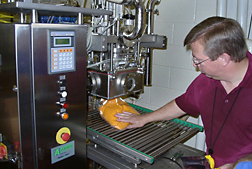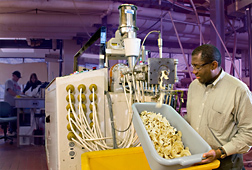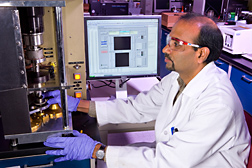ARS Research From Lab to Market
|
|
Hydrogen is often touted as a fuel of the future, and it’s produced by some of the world’s tiniest organisms. Now a patent-pending “green” technology from the Agricultural Research Service holds promise as a source of hydrogen for use in fuel cells that power pollution-free cars and more.
Probiotics—supplements that contain beneficial microorganisms—aid the immune and digestive systems of humans and other animals. ARS scientists are now developing probiotic bacteria that may lower blood pressure and protect dairy foods from harmful microbes. And some other ARS-tested probiotics are now being used in pet products.
These are just a few examples of how ARS research discoveries move from the laboratory to the marketplace and ultimately to consumers.
Technology transfer is the process by which successful government research, often conducted over long periods of time, is moved to private companies for further development and commercialization. Often, business owners protect their development investment by licensing patent-protected research. Other times, patent protection is not desirable, such as when ready access to research benefits the most end users quickly.
Either way, ARS has been credited with more than 800 new patents and 1,300 cooperative research and development agreements, which enable ARS scientists to work with commercial businesses on research projects of mutual importance. ARS has entered into more than 300 license agreements with business and nonprofit organizations. ARS has also entered into an average of 3,000 new partnership agreements per year with a variety of universities, nonprofit organizations, government agencies, and other industry groups in the past decade.
Some recent partnership developments are described here.
Clean Energy From Tiny Organisms
Renewable sources of energy—such as hydrogen—that don’t produce greenhouse gases are needed to solve global energy shortages. Fossil fuels—coal, oil, and natural gas—are nonrenewable energy sources implicated in global climate change.
A new green technology developed cooperatively by ARS and North Carolina State University (NC State) scientists could lead to production of hydrogen from nitrogen-fixing bacteria.
The patent-pending invention could provide a source of hydrogen for use in fuel-cell technology. Fuel-cell devices combine hydrogen and oxygen to produce electricity and water and are considered efficient, quiet, and pollution free. Fuel cells are now being tested in a range of products, including automobiles that release no emissions other than water vapor.
ARS scientists Paul Bishop and Telisa Loveless and NC State scientists Jonathan Olson and José Bruno-Bárcena developed the technology, which is now available for licensing.
|
|
Purée Opens Markets for Sweetpotato
Sweetpotato is often called a nutritional powerhouse. Now, a patent-pending process has widened the market for using sweetpotatoes as an ingredient in food products. In 2007, the U.S. sweetpotato crop was estimated at a value of $374 million.
All shapes and sizes of sweetpotatoes can be used in a new purée that, after processing, can be stored unrefrigerated and is shelf stable for more than a year. The purée is now being used by manufacturers and food-service distributors as an ingredient in baked goods and baby foods.
The purée is made by rapid microwave heating. The unique process was developed, tested, and jointly patented by collaborators with ARS and NC State, both in Raleigh, North Carolina; and Industrial Microwave Systems, L.L.C., in Morrisville, North Carolina.
ARS food scientist Van-Den Truong, with the Raleigh-based Food Science Research Unit, and his collaborators tested the product extensively at an NC State pilot plant.
Snow Hill, North Carolina-based Yamco LLC licensed the process for exclusive commercial production of the purée. The company is solely owned by seven North Carolina sweetpotato growers.
Whey-Protein Muscle Puffs
A variety of starch-based snack products now boast up to 35 percent more protein, thanks to value-added, specially treated whey proteins. Whey, a byproduct of cheese manufacturing, normally would not combine easily with starches because of differences in molecular shape and structure.
But ARS scientists found that blended corn and whey-protein products could be puffed, or extruded, under high-pressure and low-moisture conditions. The resulting products are expanded and crunchy, rather than shrunken and tough.
ARS food technologist Charles Onwulata worked with Philadelphia, Pennsylvania-based Jerome Harden with Harden Foods, Inc., under a cooperative agreement to commercialize the ARS-patented ingredient. Onwulata is with the ARS Eastern Regional Research Center in Wyndmoor, Pennsylvania.
The company later licensed the technology and has introduced a new branded line of healthy snack foods, including cheese curls, tortilla chips, and corn chips. Harden Foods has also entered into agreements with other businesses to develop an array of nutritional products for the sports nutrition market, including fitness centers and retail stores. One such product, called “Muscle Puffs,” contains 5.5 grams of protein per serving.
New Sweetener on the Block
Energy drinks, snack bars, shakes, and breakfast cereals that can help people with diabetes manage their diet are boasting a new slow-release carbohydrate-based sweetener. The carbohydrate syrup, called sucromalt, was developed under a trust-fund agreement between ARS chemist Greg Côté and geneticist Tim Leathers and scientists at Minneapolis, Minnesota-based Cargill, Inc.
Carbohydrates that are quickly digested and absorbed result in a rapid rise in blood glucose levels and can be considered high-glycemic-index foods. But sucromalt, having 70 percent of sugar’s sweetness, is considered a low-glycemic-index sweetener that provides a blunted glycemic response in the body.
The ARS team’s biocatalysis technology was licensed to Cargill, which has filed three patent applications covering the process of making sucromalt—or its use in various food products.
Metalworking Fluids Go Green
Alcoa, Inc., executives couldn’t wait to replace mineral-oil-derived lubricating fluids with new cost-effective soybean-oil based fluids. Alcoa is the world’s leading producer of primary and fabricated aluminum and alumina.
To help reduce its dependency on nonrenewable petroleum-based products, Alcoa contacted the ARS National Center for Agricultural Utilization Research (NCAUR) in Peoria, Illinois, to discuss developing biobased lubricating and metalworking fluids. These fluids keep aluminum metal from welding to steel rollers used to produce the aluminum sheets for everything from beverage cans to aircraft-wing panels.
A team of ARS scientists, led by chemist Sevim Erhan in NCAUR’s Food and Industrial Oil Research Unit, worked with Alcoa on new technologies under a cooperative agreement. The resulting biobased fluids perform well and conform to industrial standards. And when vegetable oil is used instead of petroleum, Alcoa earns carbon credits and reduces worker exposure to chemicals and fumes emitted by petroleum-based fluids.
Biobased metalworking fluids have now been tested or used at Alcoa facilities in Reno, Nevada; Lancaster and Pittsburgh, Pennsylvania; Texarkana, Texas; Davenport, Iowa; Cleveland, Ohio; Point Henry, Australia; and Fusina, Italy.—By Rosalie Marion Bliss, Agricultural Research Service Information Staff.
This research is part of Quality and Utilization of Agricultural Products, an ARS national program (#306) described on the World Wide Web at www.nps.ars.usda.gov.
To reach scientists mentioned in this article, contact Rosalie Bliss, USDA-ARS Information Staff, 5601 Sunnyside Ave., Beltsville, MD 20705-5129; phone (301) 504-4318, fax (301) 504-1486.
"ARS Research From Lab to Market" was published in the March 2009 issue of Agricultural Research magazine.









